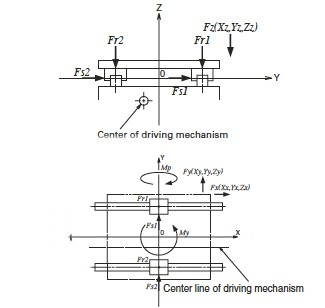- Home
- Products
- Video
- Blog
- Projects
- Quality Control
- About ALM
- News
- Support
- Contact Us
Views: 33 Author: Site Editor Publish Time: 2023-02-08 Origin: Site

Linear guides and bearings provide high stiffness and good travel accuracy.They can support not only downward,upward and sides loads,but also overhung,or moment loads.Of course,the larger the linear guide and bearing system,the greater its moment capacity,but the arrangement of the bearing races-face-to-face or back-to-back also affects the amount of overhung loads it can withstand.
While the face-to-face design(also known as the "X" arrangement)provides the same load capacity in all directions,it results in a shorter moment arm to apply the overhung,which reduces the moment load capacity.

The face-to-face raceway arrangement results in a shorter moment arm and lower moment capacities.
A back-to-back arrangement(also known as an "O" arrangement) provides a larger moment arm and offers a higher moment load capacity.
The back-to-back raceway arrangement produces a longer moment arm and higher moment capacities.
However,even with a back-to-back arrangement,linear guides have a relatively short distance between the raceways(essentially equal to the width of the rail),which limits their ability to handle rolling moments,which are caused by overhung loads in the Y direction.To overcome this limitation,the use of two guideways in parallel(with one or two bearings on each)allows the rolling moment to be broken down into forces on each bearing block. Since linear bearings have a much higher force tolerance than moments(especially rolling moments),bearing life can be significantly extended.Another benefit of using dual guideways and allowing moments to be broken down into forces is that linear bearings typically deflect less under pure forces than under moment loads.

When dual guide rails with one bearing each are used,no roll moments(Mr)are induced;only pitch (Mp)and yaw(My)moments.
When dual guide rails with two bearings each are used,only downward(Fr)and side(Fs)forces are induced; no pitch,roll,or yaw moments.
Many linear actuator designs include two parallel rails with the drive mechanism(belt, screw or linear motor)integrated between the rails.While the actuator does not have to be centered between the rails,doing so helps ensure uniform loading of all bearings and reduces the cogging effect or uneven drive forces on each rail and bearing set.This arrangement also reduces the height of the actuator,making it relatively compact considering the high load and torque capacity provided by the dual guideways.

Linear actuators with dual guides provide high rolling moment capability.
Recirculating bearings(bushings)mounted on a circular shaft cannot handle rolling moments.This is why most linear bushing applications require two shafts to be used in parallel.
Click to select ALM high quality linear motion components for your application:
www.autolinearmotion.com/products.html